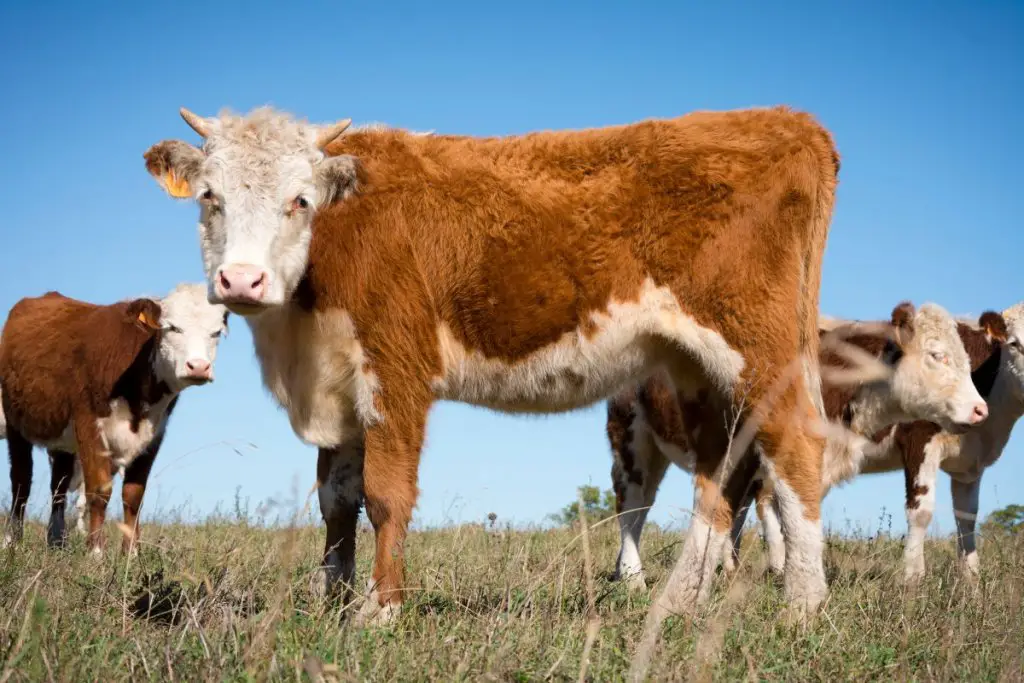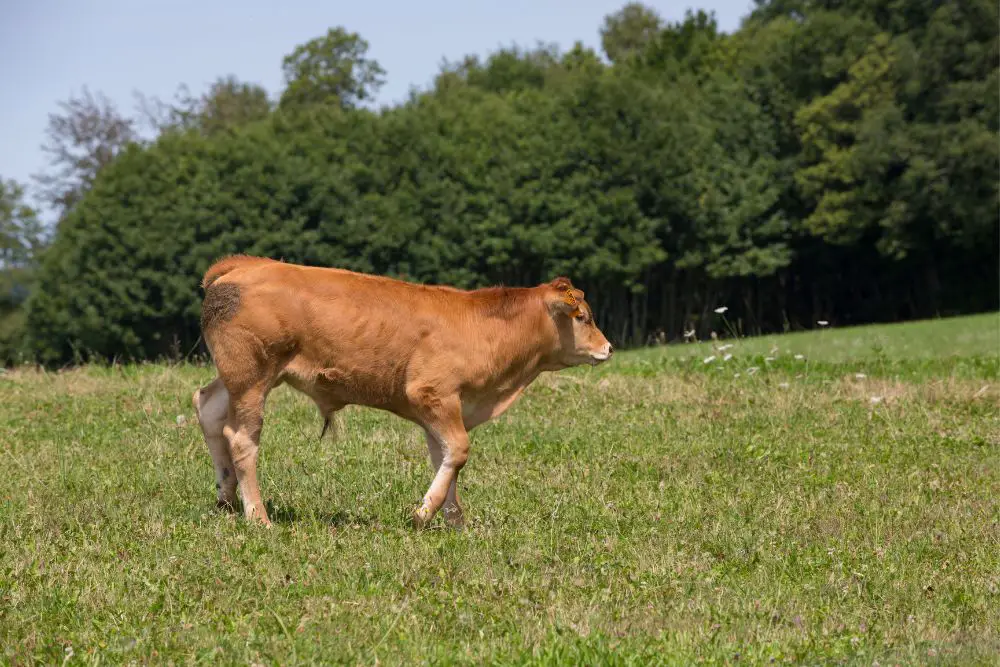Buying beef cattle requires choosing the right breed at the right price, providing sufficient feed and treating this like a business. With planning and preparation, you can avoid many of the common pitfalls and frustrations that new farmers face.
Before buying your first beef cattle or two to add to your cow herd, there are some important factors to conside to make raising beef cattle more pleasurable and profitable.
Table of Contents
Initial Cost of Beef Cattle
Pricing and Breed Selection
As with almost anything you purchase, cow prices will vary, and in most cases, you get what you pay for. The cow cost will depend on your preferred breed, season and availability.
Here are some of the best options to consider:
- Bottle calves: This is one of the cheapest ways to get beef cows. However, remember that you will make a bigger investment when feeding and taking care of the youngster
- Yearlings or older calves: The average price of these animals will vary depending on the demand, live weight, and quality of the cattle and the time of the year
- Show stock and breeding: These bovines are offered on a per-head basis. A young show steer or champion bred heifer will cost the most and are unnecessary for profitable beef farming
Beef cattle are priced depending on weight of the cow, with hundredweight (CWT) being the unit of measurement, representing 100 pounds.
Check local agricultural magazines, Facebook groups or visit a nearby auction to get a good idea of the cow costs in your area.
Transporting Them Home
If you don’t have a good way to get your beef cattle home, you should ask the seller if they deliver and what their price is for the service. Cows hate change, so consider buying the same feed from the seller to help them adapt to the change.
Once you get the cattle home, you may want to vaccinate them for common diseases in your area.
Working With A Vet
If one of your cows stops eating, has trouble breathing, or shows any other signs of sickness, contact a vet as soon as possible. You don’t want your family cow to suffer, so keep up with your cow’s health.
A good working relationship with a veterinarian can be vital to the success of your beef cattle-keeping experience. A good vet will guide you in establishing a proper health plan for your cattle, help find ways to improve your cattle’s health, and be a godsend in emergency situations.
Feeding Your cattle
All cows need water, protein, fats, carbohydrates, vitamins, and minerals in their regular diet. These can come from different sources, but make sure they are well balanced to help meet your cattle’s nutritional requirements.
Forages like hay and pasture can meet the nutritional requirements of mature cows, but they might not meet the needs of fast-growing beef cattle. Therefore, energy or protein sources should be added to the diet to meet the needs of young and rapidly-growing cattle.
Grain supplements can also be used for rapidly-growing cattle to boost beef production.
Keep in mind that beef cattle can eat a lot of forage. Consult an extension agent (also called officers or specialists in some countries) to figure out the average cost of feed and how many cows per acre you should keep on your property.
Farm Setup Costs
You will need a minimum of two paddocks to help you rotate your cattle. Intensive ranchers and farmers rotate their cows daily, but weekly rotation to new grass as other paddocks grow is enough.
You should also consider housing costs for fencing, shelter, and pasture which vary considerably depending on what you want to achieve.
If you already have shelter, you can spend more elsewhere. Regardless if you construct a basic barn or buy a small structure for your cattle, you WILL need to account for transport and labor costs, not just the materials. Your own time and labor has a cost.
The costs of installing woven-wire, barbed-wire, or an electric fence will vary depending on type of fencing material you use. Electric fences are the most expensive long-term but their benefits typically outweigh their costs.
Butchering cows is a complicated task and requires certain tools and special skills, so it’s vital to determine where you’ll be slaughtering your beef. Grass-fed beef cattle will be ready for slaughtering at about 28-30 months, whereas grain-fed cattle will be ready at around 15-16 months
If you intend to keep the meat for your family’s consumption, you should choose a custom slaughter house and freezer, but if you want to sell the meat, the slaughter facility will require frequent inspections.
3 Best Beef Breeds for Beginners
Each beef cattle breed has unique traits. You should consider those traits when choosing the breed that best suits your operation.

When choosing a breed, make sure to consider the following factors:
- Availability
- Market prices
- Hair color
- The presence or absence of horns
- Your climate
- Feed sources
- Crossbred vs purebred bloodlines
Here are 3 breeds ideal for beginners:
Angus
The Angus cattle breed made its way to the US from Scotland in 1873. This all-black cattle was quite unique at that time because it was hornless and today, Red Angus have become more popular with over 250,000 registrations being recorded every year..

Angus cattle are known for their medium size and low maintenance requirements. They have excellent fleshing ability, so they gain weight fast with minimal feed.
Since they are small at birth, Angus cattle give birth more easily than many other breeds while their carcass has great marbling ability and attracts good beef prices.
Hereford
Hereford is a British cattle breed that originated in Herefordshire, England. This breed is renowned for its hardness and adaptability to different climates. Females weigh about 1200 pounds, while males weigh up to 1800 pounds.

They are large and muscular, with medium-length side length and a proportionate leg length. They are also well-built in parts such as the hindquarters, back, and loin.
Herefords are mostly calm and docile, making them a great choice for beginners.
Limousin
Limousin originated in western France. Red gold in color and very muscular, these old cattle grow very rapidly. Some cow-calf producers have developed a black version.

Limousin has also been mixed with other cattle breeds to increase its size, muscle mass, and weaning weight.
For additional breeds, check out these two guides:
FAQs
What is the most profitable breed of cattle?
Angus beef are extremely popular due to their profitability. They produce high quality meat and around 50% of their weight is meat.
Hereford are also very profitable, but is cheaper than Angus. These animals mature quickly and are an excellent choice for new farmers.
What is the fastest-growing beef cattle?
Among the most popular beef cattle breeds, Gelbvieh is the fastest growing breed in America. Its demand is constantly increasing among consumers and ranchers while other breeds like Angus are experiencing a slow decline in feeder cattle demand and sales.
How Long does it take to raise a beef cow for slaughter?
It takes around 2 years to raise beef cattle for slaughter, but the duration will vary depending on the breed, the expected hanging weight, and the desired purpose of the meat.
